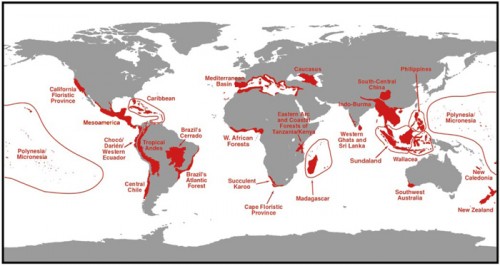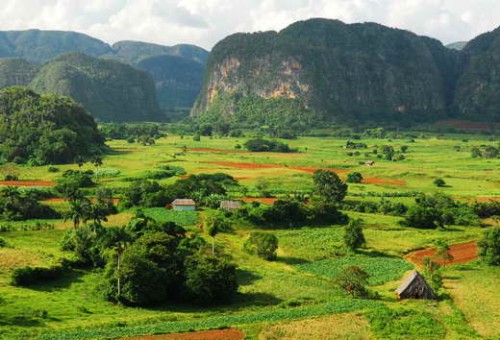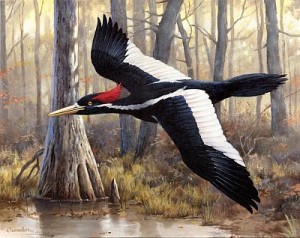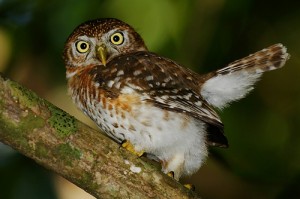Where Dinosaurs Roam
February 29, 2012 by nialexandre
Ideally situated between the tropics of Cancer and Capricorn, Cuba, the largest island in the Caribbean, benefits from very high amounts of direct sunlight and rainfall. Natural sciences tell us that heat and water are key components to life, and the combination of both result in some of the most extensive biodiversity levels found on Earth. All across the globe, more species are found in the equatorial zones, both on land and in water, than anywhere else. However, because of the complex trophic and energetic patterns that millennia of evolution have created, this species abundance exists in a delicate equilibrium that is all too easy to upset. Although humanity has always pushed the limits of this balance’s resilience, through the rapid industrializations of the past century our impact has increased astronomically, and many of these biologically rich zones are greatly in danger of loosing a majority of their species.
Cuba, however, due to a unique socio-political climate, has been able to retain an extraordinarily high amount of its initial biodiversity. Although Cuba had suffered severe environmental degradation during the early 1900s, the combined impact of the US’s trade embargo and the disappearance of Soviet aid cut Cuba from the drive of capitalism that pushed many countries into privileging industrial development over ecosystem conservation. Thus, accidentally perhaps, Cuba’s natural systems were exempt from many of the effects of excessive pesticides, direct CO2 pollution, and other environmentally dangerous by-products of developing nations. Today, Cuba has the highest proportion of protected forests in Latin America and the Caribbean, with an aproximate percentage of about 22% of Cuba’s national territory placed under protection due to its biodiversity.
One of the most unique features of Cuba’s biodiversity is found along Cuba’s North Western boarder. Recognized as a UNESCO world heritage site for a landscape that ‘illustrates significant stages in human history,’ Viñales Valley is known for both its extensive and traditional tobacco leaf production and it’s otherworldly rock formations called mogotes, or haystacks. Mogotes are limestone based karstic formations created by the combined impact of heavy erosion and tectonic uplifting. They tower above rich, alluvial soils created by the nutrients that slowly erode off them when it rains, which explains why tobacco plantations are still so popular in the valley. The eroding waters have riddled these haystacks with caverns, grottos, and subterranean streams.
The immense size and structure of mogotes makes them particularly hard to access by conventional means, particularly for local flora and fauna. Each of them is, in effect, a secluded biosphere in an island-nation that has been biologically isolated for thousands of years, allowing species to evolve independently from one another in very small area. Although a land version, and admittedly on a smaller scale, mogotes have been compared to Darwin’s Galapagos Islands. Each is home to a great variety of endemic plant species, birds, and a number of gastropods and small amphibians that evolved separately from the species living on the neighboring mogote. Very little research and full species classification has been done on them to date, in part, and not for lack of being inventive, because Cuban scientists don’t necessarily have the funds and equipment to identify and inventory the fauna and flora there.
However, just as with Darwin’s Islands, the native species living in, on, and around the mogotes face rising threats of extinction due to increased tourism. Vinales Valley is a choice tourist destination not only because of its location (just out of Havana), its majestical scenery removed from time (what other extinct species might be hidden just around that outcrop?), but also for the spelunking and rock climbing tourists can enjoy there. An increase in the demand for tobacco, and the much needed revenue it would generate, also has plantations expanding and developing, which furthers the risks to the mogotes‘ endemic species. All of these activities impede upon the natural habitats of the unique, and in come cases undiscovered, specifies present – threatening to destroy them forever.
As Cuba returns to the world scene, the impetus to privilege economic development over natural conservation will become an increasingly prominent consideration for both the government and the cuban population as a whole. The direct economic impact of Cuba’s natural beauty is minimal, representing only about 4% of the tourist industry, in part because the government closely monitors the number of people that visit the protected areas. But Cuba’s natural beauty and richness has never been reduced to simple economic benefits, from the early days of the islands discovery where its lushness was greatly praised by José Marti, to the modern day where conservation methods are actually incorporated into the Cuban constitution (Article 27).
So where is Cuba going? The lush island-nation is faced with the delicate opportunity of striking a balance between preserving a biodiversity so rich it seems to be a thing of the past and economic development to improve the lives of its citizens. The difference between Cuba and the rest of the world is that its people are acutely aware of the effects development can have on their natural landscape, and now have the chance to do better than we have in preserving its natural heritage, both known and unknown, modern and ancient.
*
Additional sources
Patricia Grogg, “Cuba Encourages Ecotourism in Largest Wetland”
8 Responses to “Where Dinosaurs Roam”
Leave a Reply
You must be logged in to post a comment.




Gloucester Electrician
Electricians brockworth
repair of fascias soffits chalford hill
typical exterior painters
gloucesterelectrician
carpet Cleaning Tewkesbury
Elodia Terando
Elouise Sowerby